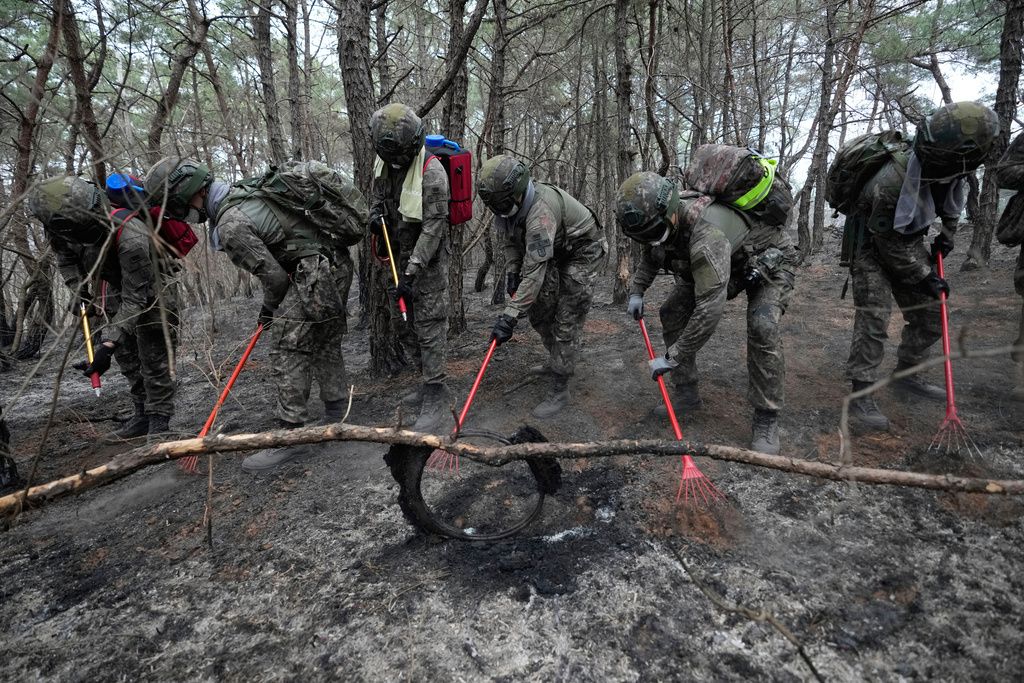Rain and cooler weather help South Korean fire crews battle devastating wildfires

South Korean army soldiers work to prevent the further spread of wildfires in Uiseong, South Korea, Thursday, March 27, 2025. (AP Photo/Ahn Young-joon)
SEOUL, South Korea (AP) — Rain and cooler temperatures are helping South Korean fire crews as they battle the country's worst-ever wildfires on Friday, as the governor of the hardest-hit region called for overhauling response strategies to respond to the climate crisis that he says worsened the disaster.
The wildfires, which have killed 28 people and razed vast swaths of land in the southeast in the last week, were 85% contained as of Friday morning, Korea Forest Service chief Lim Sang-seop told a televised briefing. He said authorities will launch "all-out efforts" to extinguish the remaining blazes by bringing more helicopters and fire fighters to the areas.
The raging inferno has also destroyed thousands of houses, factories, vehicles and other structures, while mountains and hills were stripped of anything but a carpet of smoldering ashes.
"Hazes have been diminished because of the rain last night, so that's favorable for securing visibility. Also, temperatures are now lower than the last few days, so things are very favorable to put out the wildfires," Lim said.
Firefighters — many in their 60s, a reflection of one of the world's fastest-aging populations — navigated forests in yellow helmets and red protective suits, spraying suppressants at flames that flickered near their feet. Helicopters dropped buckets of water over hills that glowed red in the night.
Residents hunkered down in temporary shelters in places like schools and gyms, but the fire crept dangerously close to some of them too. A video shared by one evacuee shows blazes approaching a school soccer field under a sky choked with smoke.
"I just kept crying this morning," said 79-year-old Seo Jae Tak, an evacuee at a gym in Andong city, on Thursday. "When I went back yesterday, the entire mountain had turned to ashes. It's just unbelievable, I can't even put it into words. All I can do is cry."
Authorities were mobilizing about 9,000 people, 125 helicopters and hundreds of other vehicles to battle the wildfires, the government's disaster response center said.
The wildfires have burned 47,860 hectares (118,265 acres) of land, forced more than 30,000 people to flee their homes and injured 37 others since last Friday. Officials said Friday that 8,000 residents remained at temporary shelters. The fires have been driven by strong winds and dry weather.
While it's hard to link any one event to climate change, officials and experts say that it is making wildfires more likely and more severe. Scientists have already warned the warming atmosphere around the world is driving ever more extreme weather events, including wildfires, flooding, droughts, hurricanes and heat waves that are killing people and causing billions of dollars in damage every year.
"We must completely overhaul our wildfire response strategy in the face of extreme climate conditions," said Lee Cheol-woo, governor of North Gyeongsang Province, in a news conference.
Lee noted that the past week has shown how wildfires, fueled by dry and windy conditions, can quickly overwhelm the country's resources. He said he would request that the government establish better evacuation guidelines, adopt more powerful firefighting tools including aircraft equipped with water cannons, and adopt other approaches to improve firefighting efforts during nighttime hours.
"We don't have the equipment for firefighting at night," Lee said. "In the night, firefighting is done solely with manual efforts, but with the increased density of our forests compared to the past, it's difficult to manage with just that."
On Thursday, Lee Han-kyung, deputy head of the disaster response center, told a meeting that the wildfires showed "the reality of climate crisis that we have yet experienced," according to Yonhap news agency.
The people killed were mostly in their 60s or older. They include a pilot whose helicopter crashed during efforts to contain a fire Wednesday and four firefighters and other workers who died earlier after being trapped by fast-moving flames. Officials say older people found it difficult to evacuate quickly but have not provided details of the civilian dead.
In Uiseong, about 20 of the 30 structures at the Gounsa temple complex, which is said to have been originally built in the 7th century, have burned. Among them were two state-designated "treasures": a pavilion overlooking a stream that dates to 1668, and a Joseon dynasty structure built in 1904 to mark the longevity of a king.